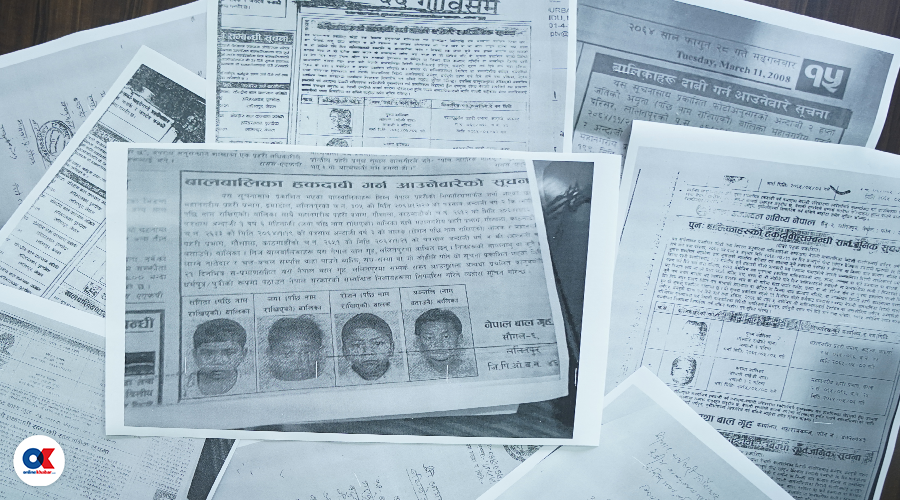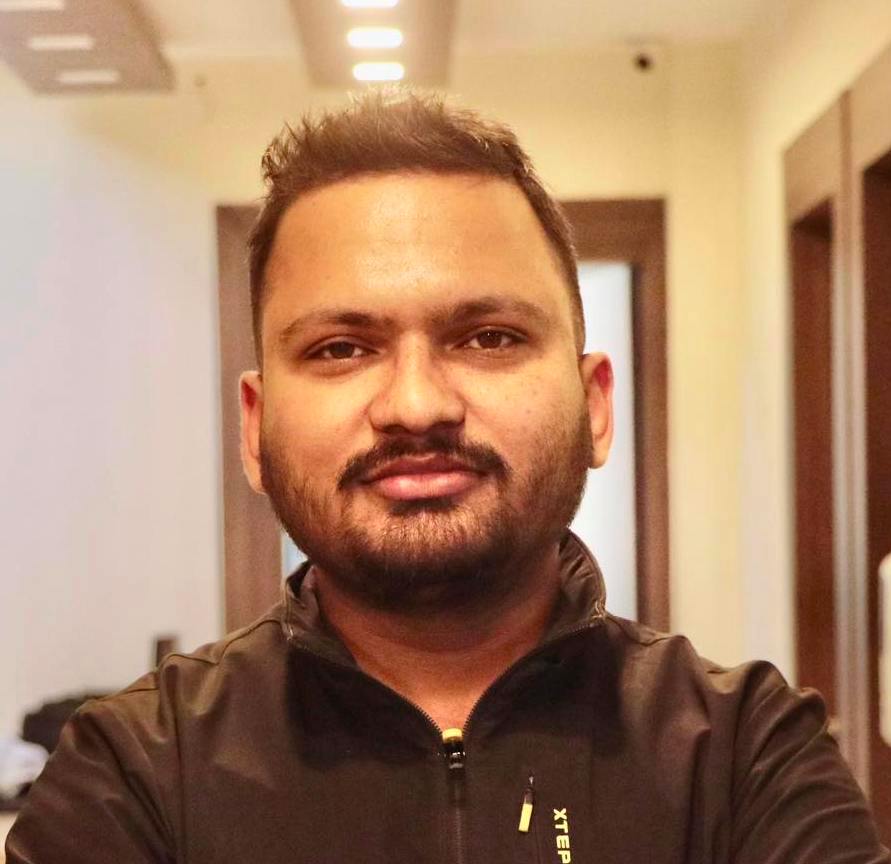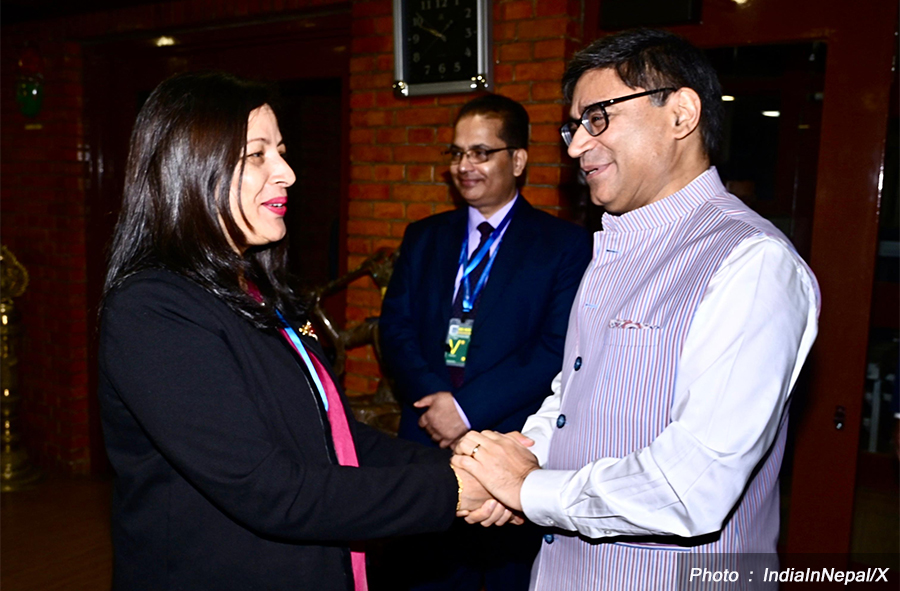
Raised in the Netherlands, Shanti Chalise was always curious about her skin colour, which differed from her family. Her parents and brother had white skin, but she had brown. Sometimes, she felt bad about it.
But after some years, another child with a similar skin colour as Chalise joined the family. Only then did she learn about Nepal.
“He was two years older than me. He used to tell me repeatedly – Shanti, we came from Nepal,” Chalise recalls. “He frequently wished to see his photos taken in Nepal.”
“My parents never told me that I was someone else’s daughter, but one day I gained the courage to ask about my true identity,” she says, “I had many inconvenient conversations with them, but they never admitted that they brought me from Nepal.”
Shanti and her struggle

In 1993, when she was 13 years old, her Dutch parents brought her to Nepal.
“Maybe my parents realised that I had a right to know about my country,” she recalls, “At that time, Kathmandu felt so strange to me.”
She also remembers rafting in Chitwan back then.
She also went to Bal Mandir, where her father inquired about her family. Back then, she came to Nepal for just a month. It was her first time travelling to Nepal.
In 1997, the person they met at Bal Mandir sent a telegram mentioning that Chalise’s mother had been found. At this time, Chalise was 17 years old. Afterwards, she came to Nepal, stayed for five months, and learned basic Nepali.
“I found an excellent Nepali teacher in Jawalakhel,” says Chalise, “After staying in Nepal for five months, I returned to the Netherlands and again in 2002 I came to Nepal.”
By then, she had found some of her old documents, which made her realise that the family members she met were not her real family. She then found a letterhead from the Nepal Children’s Organization where her mother’s name was listed as Laxmi Chalise, and the location was only Sunkoshi.
The letter issued on August 28, 1979, has a thumb impression and a signature. The letter stated, “I am willingly letting my 10-year-old daughter be adopted from anyone in the orphanage of this Bal Mandir. I will not file any complaint.”
The same letter also has an English version where her mother has expressed consent that her daughter can be adopted. After five years she found another letter from Nepal Children’s Organisation.
The letter found from the guardian in the Netherlands mentioned that a girl child named Shanti Chalise had been brought from Putalisadak, Kathmandu. It stated that she was abandoned at Bir Hospital and later handed over to the Dutch citizen by Bal Mandir.
So far, she has visited Nepal 10 times in her search for her family. She has learned that fake documents are created to send children abroad as adopted children.
“If I had started searching for my identity earlier, I would have known so many things by now,” she says.
She is now in Nepal with her husband, whom she married in the Netherlands. After learning about her homeland, she has given her two daughters Nepali names. Her elder daughter, Kumari, is 13 years old, and her younger daughter, Gauri, is nine.
“I will again come to Nepal, searching for my family and someday I will find someone. There has been an injustice in sending people like me abroad as adopted children,” she adds.
For multiple reasons, Chalise is suspicious of the letter provided by Bal Mandir to the family members who adopted her. To understand this, it is important to look at the example of Purna Chandra Bhagari from Chandannath Municipality-2, Jumla.
Files of fake documents

Bhagari, who was a shepherd at the time, got an opportunity to work in Mumbai, India. A traveller visiting his village told him he could earn more in Mumbai. Believing this, he left his wife and two children behind and went to Mumbai.
According to Bhagari, it was in 2001 when he went to Mumbai. During his absence, his wife started getting close to another man. Later, it was learned that she had left their son Bharat in the orphanage at Thapathali and went away with this man. Upon discovering this, Bhagari went to the orphanage on January 28, 2003, to learn about his son. Unfortunately, it had already been a week since Bharat had been sent to Italy.
The orphanage informed him that on January 21, 2003, an Italian family adopted his seven-year-old son Bharat.
“I tried hard to get Bharat’s documents from the orphanage, but they didn’t help me,” says Bhagari. “Later, in 2006, I received a few documents.”
Bhagari says those documents had strange details. The documents which have the signature of a constable of Balkhu Police Station have mentioned that the child with no address has been found.
Similarly, another document issued by the Directorate of Women and Children under the Crime Investigation Department of the Police Headquarters was also discovered. In the letter, it was mentioned that “Bharat’s parents were not found even after searches conducted by all police units.”
The case of Purna Chandra Bhagari vividly depicts how children are made orphans and sent to foreign lands as adopted children, despite their parents being alive.
According to child rights activist Rajesh Sharma, such fake documents are created in Nepal due to the laws in the country where the adopted son or daughter is being adopted.
Those documents are made from the embassies based in specific countries, says Sharma. That is why Chalise is suspicious about the documents she found out.
“In the documents, only a place called Sunkoshi is mentioned in the location. There are no photocopies of citizenship or photos. I once even reached Sunkoshi Rural Municipality in Sindhupalchowk, but there are many places in Nepal named Sunkoshi.”
Bhagari, who runs a small business in Jumla, has knocked on the door of government bodies and non-government organisations, demanding to search for his son, many times.
“I can’t afford to come to Kathmandu frequently. I sold my land and spent more than a million searching for my son,” he says, “Still if there is any chance that he can be found, I am ready to spend money.”
After the address of the Italian family who adopted his son was found, Bhagari sent a translated letter to them. He even attached a photo of Bharat, taken when he was a child.
In the letter, addressing his son, he wrote, “I am your father. In my absence, you were abandoned by your mother.”
Bharat’s sister is in contact with Bhagari. She is a teacher at Kohalpur Boarding School.
Police Personals Involved
After the end of civil war (1996-2006), certain individuals started visiting squatters’ settlement at Shantinagar in Kathmandu, seeking children. They claimed to have children’s homes, offering better education and care for the children if they were sent there.
They mentioned that foreigners frequently visited their institution, and if desired, the children could be sent to Europe or America. Sarita Bhujel from this settlement thought, “If I send my daughter to this institution, it would be easier for me to work, and her future could be better with proper education.”
Her eldest son had studied up to class 8, and her younger son was still growing. “I feared that if I couldn’t educate my daughter, she might end up sifting sand for a living like me,” Sarita recalls. “I was also ill at the time, and since they promised I could visit her, I didn’t think much more.”
One day in 2006, she took her 5-year-old daughter, Smriti Bhujel, to the office of an organization called ‘Prayas Nepal’ in Baluwatar and entrusted her to their care. Occasionally, Sarita would visit the office to check on Smriti’s health and well-being. She believed she had done the right thing by allowing her daughter to study there.

However, two years later, when Sarita visited the institution, she didn’t find Smriti. She learned from the staff that her daughter had been taken to Italy as an adopted child. The organization’s officials, however, didn’t provide her with much information.
Sarita submitted a request to the then Central Child Welfare Committee on May 16, 2010, asking them to help find her daughter. “For three years, my daughter was under the care of Prayas Nepal, and now I hear that she was sent abroad as an adopted child without my knowledge. Is it even possible to send my daughter away like that? I requested them to return my daughter to me in any way possible.”
The Child Welfare Committee then asked Prayas Nepal for clarification. In response, Ratna Bahadur Karki, the then general secretary of Prayas Nepal, claimed that Smriti was not taken from the squatter settlement but was handed over to them by the police.
He also submitted a document given by Saraswati Sthan Community Police Service Center, under the Durbar Marg Police Office, which states that a 5-year-old girl named Smriti Bhujel was found abandoned and admitted to the institution for care.
The clarification letter stated that a notice had been published for any claims of guardianship, but no relatives or guardians came forward to claim Smriti.
Sarita, who had personally taken her daughter to the children’s home, questions how her daughter was declared an orphan. The letter, signed by Police Officer Phulkumari Paudel, served as the basis for Smriti’s official declaration as an orphan, and the process of sending her abroad as an adopted child began.
The Ministry of Women, Children, and Social Welfare later made a decision to hand over the child to Italian citizens Giovanni Fern and Francesca Caddoli based on these documents.
Onlinekhabar traced Sarita, Smriti’s mother, to the squatters’ settlement on Thursday. “I was the one who took my daughter to the children’s home myself, but they even changed her date of birth in the paperwork,” Sarita says.
Smriti’s elder brother Kishor recalls realizing only later that all the documents had been falsified. “They published a notice in the paper claiming the child was missing, then sent her abroad, making sure they couldn’t be blamed,” he says. “Despite repeated requests to help us contact my sister, the institution refused.”

According to Sarita, another woman from the squatters’ settlement also took her child to the institution, but since her husband was with her, she decided to take her child back home instead of leaving her. “They took other children from here as well,” Sarita says. “After several requests, I was only given a few photos.”
A document found by Onlinekhabar reveals that when Smriti was handed over to foreign parents, they deposited $2,700 into the ministry’s account at the Nepal Rastra Bank. The children’s home received $5,000, and there was an agreement to provide up to $10,000 if needed.
False Promises
In 2006, the owner of the Disabled Children Education Centre told Hari Prasad Poudel of Rasuwa that his daughter Anu would receive a good education from foreigners if she was admitted to an orphanage home.
“Back then they said that they would return my daughter after a year, and the foreigners would provide quality education,” recalls Poudel, “They frequently visited my home, I believed them, and sent my daughter with them.”
According to him, the office bearer of the centre made him sign a document at Kathmandu District Office. He signed all the documents and now he regrets it.
Poudel recalls that there was a strike on that day. They forced me to come along with them and made me sign the documents.
“After I signed the documents, all of them went contactless,” he says.
Later, when he began reaching out to various organisations in search of his daughter, he discovered other parents like him whose children had been taken away with lofty promises. Afterwards, on September 2, 2013, along with Hari Prasad Poudel other four parents jointly submitted a letter to the then head of council of the minister Khil Raj Regmi, demanding to search their children.
The letter mentioned that the Education Centre for Helpless Children in Dhapasi, Kathmandu, had taken the children under the false pretence of providing care and quality education, only to make them disappear.
“The centre also promised that they would help the parents earn foreign currencies. However, since taking our children, they have not provided any information. While trying to search for the children, we have received threats,” reads the letter.
In the letter, Hari Prasad Poudel mentioned that her daughter had been missing since November 17, 2006. The daughter-in-law of Poudel, Sarita Poudel has also stated that her son Prajan Poudel has disappeared. Both of them have stated that their children have been lost in an orphanage, and they have filed a complaint, attaching copies of their citizenship.
They applied to the then Central Children Welfare Board, demanding to search their children. Then the board asked for clarification with the Disabled Children Education Centre.
Later, the president of the board, Saraswati Shrestha, stated in a written statement that Sushmita Tamang, Anu Poudel, and Prajan Poudel had been adopted by foreigners based on criteria and approval by the council of ministers and had been sent abroad.
Under the recommendation of the Ministry of Women, Children and Senior Citizens, Sushmita Tamang, Anu Poudel, and Prajan Poudel were sent abroad, as adopted children.
However, according to the terms and conditions and process for approving the adoption of Nepali children, only parentless children can be adopted and sent abroad. But the children handed over by the Disabled Children Education Centre for adoption have parents.
In 2008, the government changed the conditions and procedures to allow Nepali children to be adopted by foreign nationals after disputes started arising in adoption cases. In that order, it is stated that ‘voluntarily abandoned children’ can also be sent abroad in the same manner.
There is no exact historical record of when Nepali children started to be sent abroad as adopted children. However, some observers say that the practice has existed since the Panchayat era.
“Back then the VIP foreign guests invited by the royal family to visit Nepal used to take the children of Bal Mandir with them,” says former president of Children Peace Zone National Campaign, Rajesh Sharma.
According to experts, the practice of sending children abroad as adopted children surged during the insurgency period. Back then, foreigners had easy access to orphanage homes and could easily take children from there.
Some adopted Nepali children returned to Nepal from Germany and the USA. There were some incidents where the parents imposed violence against the Nepali children. Back then, a foreign journalist released a documentary called Paper Orphans, says advocate Rup Narayan Shrestha.
A study conducted by the Swiss embassy in Nepal found that even children who have parents were sent abroad as adopted children.
After a lot of controversy, the countries under the European Union jointly issued a statement, alleging that there was a scam in Nepal involving the adoption of sons and daughters. Later, the US Embassy in Nepal also issued a similar release.
Then for some time, the practice of sending children abroad as adopted sons and daughters stopped. However, after the end of 2006 People Movement 2, the then minister Khadga Bahadur Biswakarma again started the practice.
Prabin Silwal, a child rights activist says that besides orphanage homes, the country itself seems to be involved in sending children abroad as adopted sons and daughters.
“It is the decision of the ministry that allows the foreigners to take Nepali children as adopted sons and daughters,” says Silwal. “Once after sending the children with the foreigners, the government takes money from them.”
In the procedure regarding the adoption of Nepali children by foreigners, there is a provision to determine the price. After the procedure was established in 2001, orphanages began charging fees according to this procedure. Before that, orphanages accepted voluntary payments.
Although the procedure does not mention a fixed fee, here is an example of how transactions used to be made through government bodies.
On March 6, 2008, the District Police Range, Lalitpur, wrote a letter to an orphanage in Lalitpur, informing them that a two-day-old infant had been found. The letter requested the orphanage to provide guardianship to the infant, as the police could not locate the infant’s parents.
After five days of adopting the infant, the orphanage named her Anu and issued a 21-day notice to claim their rights over the infant. On January 5, 2009, the Central Women and Children Center of the police also sent a letter stating that Anu’s parents had not been found.
Based on the two letters of the police and the notice published in the newspaper, the District Administration Office of Lalitpur issued a certificate of orphanhood to Anu on March 30, 2009. Using these documents, the Ministry of Women, Children, and Social Welfare decided to send Anu to foreign citizens.
Onlinekhabar received a document which mentioned that the transfer process of Anu to the foreigner should be completed within 60 days. In the same document, it is asked to deposit 2700 US Dollars in the account of the Ministry of Nepal Rastra Bank.
In the document, it has been asked to pay 5,000 USD to the orphanage home.
In the third point of the paper signed by the undersecretary of the ministry, Sher Jung Karki, it is mentioned that proof of the ability to provide 10,000 US dollars to the concerned children’s home, the Central Child Welfare Committee, or the Nepal Children’s Organization should be submitted if needed.
Government lacks record

On August 14, 2009, police arrested Bal Krishna Dangol, the director of the Nepal Bal Mandir, Naxal, Kathmandu, on the charge of illegally handing over a Nepali child to a British native, Donna Smith.
At a time when the official process of handing children to foreigners was stopped, on July 28, 2009, Dangol handed over the one-month-old infant, born in Thapathali, to Smith. There was a deal of Rs 4,00,000. Police arrested Smith from Tribhuvan International Airport.
Dangol has been arrested on charges of human trafficking.
After this incident, to investigate the wrongdoings of the Bal Mandir, the government formed a five-member commission, under the leadership of former judge Hari Babu Bhattarai.
While investigating the cases related to Bal Mandir, the commission also examined the children who were handed over as adopted sons and daughters. According to the report of the commission, only the records from the year 1992 were found.
“ Till 2019, 949 children were sent as international adoptions by the Nepal Children Organisation. The information has been found from the minutes of the meeting of the family selection committee,” states the report.
However, based on the records of the Intercountry Adoption Management Development Board, the details provided by the Ministry of Women, Children, and Senior Citizens to the commission state that 25 children have been sent abroad as adopted children under the recommendation of the Nepal Children’s Organization.
The records of the Nepal Children’s Organisation show that 73 children were sent abroad from February 21, 2010, to August 6, 2018.
Keshav Prasad Upadhyay, the information officer of the ministry, said that it will take time to determine the exact numbers because the record system is not in good condition. According to the certified documents given to the commission, it seems that the government does not have any record of 876 children entrusted to foreign nationals over the past 27 years.
This is only a record provided by the Nepal Children’s Organisation. Other 49 orphanages have acquired permission from the government to send children abroad as adopted children. The owners of those orphanages are also in some way involved with the Nepal Children Organisation.
According to a study conducted by Professor Peter Selman of Newcastle University, UK, which is published on the website of the Hague Conference of Private International Law (HCCH), Nepal ranks 24th among the countries that send the most children abroad for adoption.
Nepal sent 269 children in 2004, 227 in 2005, 452 in 2006, 261 in 2007, 413 in 2008, 22 in 2009, 170 in 2010, 157 in 2011, 3 in 2012, 4 in 2014, 2 in 2015, 5 in 2016, 1 in 2017, 1 in 2018, 1 in 2019, and 3 in 2020 for adoption, according to details released in February 2024.
The families that adopt the most children are from the USA, Italy, Spain, France, Canada, Sweden, Netherlands, Germany, Norway and Denmark.
Professor Selmen mentioned that this report was prepared based on the report submitted by the relevant country in The Hague. According to this report, it seems that Nepal has sent 1,993 children abroad in the last 18 years alone.
Based on the report by the commission led by former judge Bhattarai, the government has dissolved the old committee of Bal Mandir. Following this, Vidya Upadhyaya Neupane, who has become the president of the children’s organisation, stated that the parents of children sent as foster children are now coming to Bal Mandir.
They are coming to inquire. But most of the case files are not found, Neupane says to Onlinekhabar, “However, we are trying as much as possible to search.”
Advocate Rup Narayan Shrestha says that the transfer of children without a clear record is a form of human trafficking.
SP Hobendra Bogati of the Central Investigation Bureau (CIB) of the Nepal Police also suggests that some issues related to Bal Mandir should be investigated from the angle of human trafficking.
“When Balkrishna Dangol was arrested during my tenure at the District Police Range, Kathmandu, we focused on Donna Smith,” he says, “However, there are still more aspects of this case that need investigation.”
Child rights activist Soni Bhattarai says, “The way children are sent abroad from Nepal as adopted children is legal human trafficking.”

























